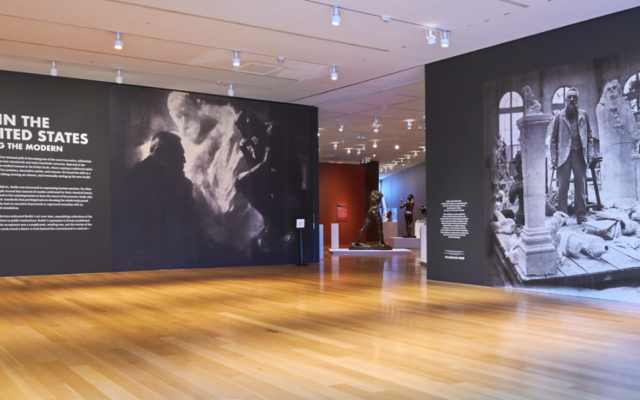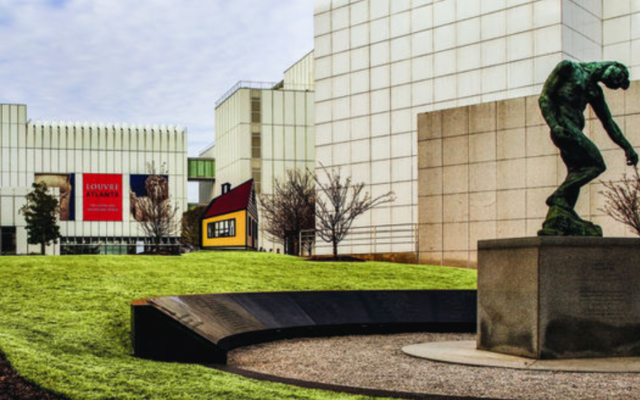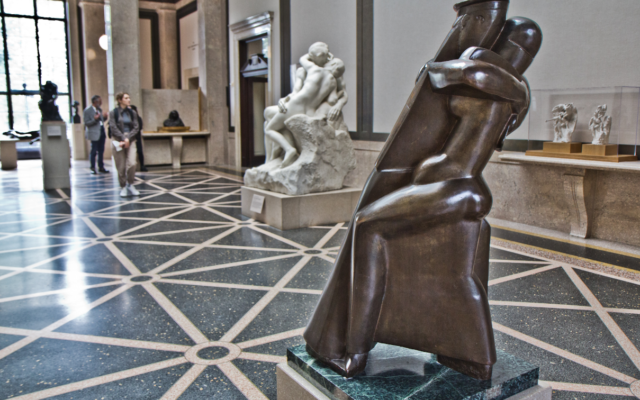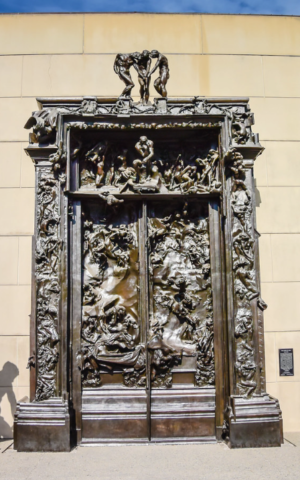High Museum’s Rodin Exhibit Has Strong Jewish Roots
Two wealthy American Jewish art collectors played a major role in promoting the appreciation of Rodin’s work in this country.

The great French sculptor Auguste Rodin produced some of the most popular artistic works of modern art. His bronze sculpture of “The Thinker,” in which a man is captured in a moment of deep contemplation, is among the most reproduced works of the last 160 years. Likewise, his study of “The Kiss” in which a couple is sharing an intense romantic embrace seems to define, for many, the nature of passion itself.
Both of these iconic works, which are now part of a major exhibition at Atlanta’s High Museum of Art, might have had a different history, if it were not for the work of two important American Jewish art collectors.
Philadelphia businessman Jules Mastbaum and Wall Street trader B. Gerald Cantor are important figures in the fascinating story of Rodin’s popularity in America. In the exhibit, “Rodin in the United States: Confronting the Modern,” the High’s director, Rand Suffolk, pointed out that the exhibit is about how an appreciation of the French sculptor developed in this country.

“This exhibition takes the audience on a journey as Rodin’s reputation builds, declines, and rises again. It’s a fascinating story, illustrated by many of Rodin’s most striking and beautiful works,” Suffolk said.
The interest in Rodin over the years owes much to Cantor and Mastbaum, both of whom did much to establish and perpetuate Rodin’s legacy in America.
In the 1920s, the early movie theater millionaire, Mastbaum, and his wife, Etta, not only purchased a large Rodin collection, but built one of the most important museums in the country devoted to a single artist. His Rodin Museum, on Philadelphia’s Benjamin Franklin Parkway, gave America a lavish showplace for the works that the couple had fallen in love with when they visited Paris in 1924, seven years after Rodin’s death.

Most significantly, they underwrote the first bronze casting of Rodin’s greatest masterpiece, his “Gates of Hell.” It is in the form of a monumental pair of doors, standing 18 feet high and 11 feet wide. Rodin spent almost 25 years creating them.
Today, separate castings of the work adorn both the Mastbaum museum, that is now a part of the Philadelphia Museum of Art, and the Musee Rodin in Paris, that is run by the French government. In fact, according to the High Museum’s curator of European art, Claudia Einecke, Etta Mastbaum was the first to establish an official collection of Rodin’s work outside France.
“It is really amazing that she managed to do that,” Einecke said, “because, at that time, in the 1920s, the Musee Rodin in Paris had all the authority over his work. The museum was established by the government after Rodin willed his collection to France. It was the Mastbaums who negotiated, I assume with the French government, to get the authority to create another Rodin museum in the U.S.”
Unfortunately, Jules Mastbaum died suddenly and did not live to see his museum open. The official dedication occurred on Nov. 29, 1929, a month after the stock market collapse that fueled the Great Depression.

Ironically, it was the rise in the stock market years later that shaped the career of the other important Jewish promoter of Rodin’s work, B. Gerald Cantor. In the post-World War II era, his firm, Cantor Fitzgerald, became one of the leading dealers in government securities.
He devoted much of his fortune and his later life to helping to promote the interest in Rodin during the second half of the 20th century. According to art expert Laure de Margerie, who spoke at the High Museum on Dec. 8, Rodin has the ability to strongly stir our emotions.
“It’s sometimes difficult to understand,” de Margerie commented, “but there is this feeling of intensity and might that makes you feel you are in the presence of genius. It is as though there is something there that is superhuman, in a way.”
Cantor was so moved by Rodin’s sculpture that, over the years, he amassed the largest private collection of the artist’s creations. Through his foundation, many have been donated to more than 70 museums, including the Iris and B. Gerald Cantor Center for the Visual Arts at Stanford University.
Like Mastbaum, Cantor sponsored numerous bronze castings of the great artist’s works, including a massive set of the “Gates of Hell” doors, which he presented to Stanford. Sculptures from both the Mastbaum and Cantor collections are included in the show at the High Museum.
Sadly, tragedy is also associated with Cantor’s legacy. In 2001, five years after his passing, the offices of Cantor Fitzgerald, located at the top of the World Trade Center, were engulfed in flames after the attack on 9/11. All 658 employees working in the office that day lost their lives.
Notably, the High Museum’s own important work by Rodin, “The Shade” was a gift by the French government in memory of the 106 Atlanta patrons of the arts who died in a plane crash outside Paris in 1962.
- Arts and Culture
- Local
- Bob Bahr
- Auguste Rodin
- art
- Sculpture
- The Thinker
- The Kiss
- High Museum of Art
- Jules Mastbaum
- B. Gerald Cantor
- Rand Suffolk
- Benjamin Franklin Parkway
- Rodin Museum
- Gates of Hell.
- Philadelphia Museum of Art
- Musee Rodin
- Claudia Einecke
- Etta Mastbaum
- Great Depression
- World War II
- Laure de Margerie
- Iris and B. Gerald Cantor Center for the Visual Arts
- Stanford University



comments